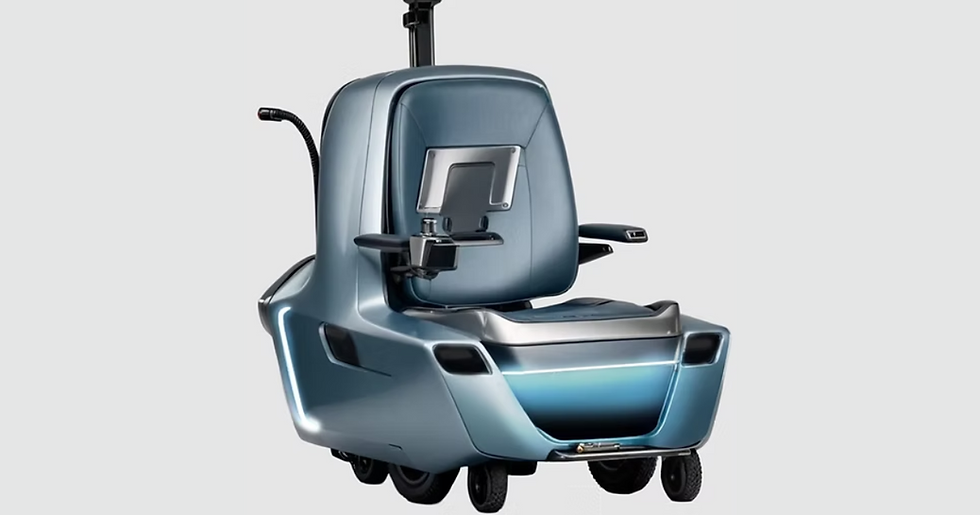Top Benefits of Autonomous Self‑Driving Wheelchairs for Elderly and Disabled Users
- Jessica
- Aug 6
- 3 min read

Autonomous self‑driving wheelchairs give you transformative benefits, especially for elderly and disabled people at home.
These robots for senior care empower users with technical safety, mobility, and independence—delivered through intuitive automation and sensor‑driven technology with an easy processing system.
Why Do Autonomous Wheelchairs Matter?
These emerging technologies and tools mitigate the basic struggles experienced by older and disabled persons.
Some of them are mentioned below:
Daily travel exhaustion.
Dependence on helpers for locomotion.
Restricted mobility across different environments when required.
Manual effort control.
These challenges can be eased using SLAM (Simultaneous Localization and Mapping), LiDAR, vision sensors, AI, and other sensors. These technologies provide fully autonomous pathfinding and obstacle avoidance navigation for flexible mobility within complex environments.
Core Benefits
Increased Independence & Mobility
Autonomy & Relocation Self-navigating powered robots for hospitality enable users to travel greater distances and navigate both indoors and outdoors independently. It fosters independence and reduces reliance on caregivers.
Enhanced Safety & Collision Avoidance
With LiDAR, sonar, and vision sensors, these wheelchairs tip and avert hazards automatically. Hazard detection with real-time risk assessment improves safety during movement.
Health & Physical Well‑Being
Self-guided systems minimize the physical effort of navigating and the risk of navigating a chair, reducing fatigue and risk of upper-body injuries. Some, like the PulseRide, even assist healthy exertion with real-time physiological monitoring, enhancing system health.
Psychological & Social Benefits
Enhanced autonomous seating fosters enhanced self-esteem and community engagement, promoting emotional well-being. Elderly users report enjoying the interactive features like speech feedback and comfort-tailored speed adjustment.
Connected Features & Health Monitoring
Vital Monitoring Some smart wheelchairs are equipped with IoT sensors and other devices to automatically track and transmit key vitals like heart rate and oxygen, sending real-time data directly to caregivers and clinicians. Thus, providing you with proactive monitoring and support.
Real‑World Examples & Research
Singapore–MIT and Panasonic Pilot Models
SMART’s autonomous wheelchair, showcased at Singapore’s Changi General Hospital, and Panasonic’s WHILL NEXT at Tokyo’s Haneda Airport. These models demonstrate real-world feasibility. They use LiDAR mapping, destination selection, navigation apps, avoiding obstacles, and automatic return-to-base station functions.
European Swarm‑AI Projects
The REXASI-PRO initiative applies trustworthy AI and machine learning with drone navigation for autonomous outdoor use safely and reliably. Unique, transparent AI systems and obstacle detection are vital for safe usage across environments.
Shared‑Autonomy & Adaptive Effort Control
WeHelp’s framework merges sequential autonomous following with teleoperation and remote control. PulseRide optimally adjusts assistance based on the user’s physiological feedback to peripheral exertion and comfort.
User Preferences & Social Behavior
Research from Japan showed social behaviors, including announcers and accelerators, enhanced user acceptance, particularly with seniors, in many cases surpassing humans in ease of use.
Side Benefits: Caregiver Support & Operational Efficiency
Low mobility Robotic systems mitigate routine mobility tasks and, in turn, reduce physical strain on caregivers.
Delivery robots and airport robots enable scalable deployment in hospitals, airports, sensor facilities, and public venues through remote monitoring and automated fleet control systems.”
Use Cases & Key Applications
Senior living facilities & hospitals: Indoor navigation, recreation, and mealtime mobility.
Airports, malls & public venues: Self-boarding, self-return to docking stations.
Home & community: Smartgate and door integration with automated facilities for effortless passage.
Considerations for Implementation
Not all models support every terrain; therefore, make the choice according to your own selection based on the environment.
Basic power chairs may appear to have a lower initial cost, but heightened independence and a broad feature set provide long-term value.
Ethical design frameworks must always ensure that technologies provide supplements, not replacements, for caring human empathy.
Conclusion
The development of self-driving automated wheelchairs is an innovative milestone in robotics designed for eldercare and more broadly for robots in hospitality, providing new levels of autonomy, safety, and self-actualization for elderly and physically challenged users. Here at HelloGard, we are motivated by these advances and are dedicated to making mobility innovations that matter.
Learn more about the transformational potential of self-driving wheelchairs for daily living by getting in touch with HelloGard. We will work with you to customize solutions for enhanced independence and improved living standards.




Comments